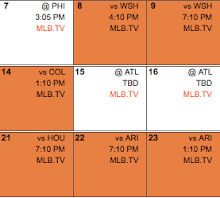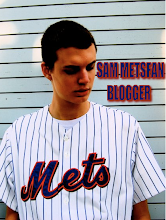SPOTLIGHT ON PAGAN, RED HOT METS
A decade ago, even a casual baseball fan could name an all-star team’s worth of players from Puerto Rico: Carlos Delgado at first base; Roberto Alomar at second base; Juan Gonzalez, Ruben Sierra and Bernie Williams in the outfield; and Sandy Alomar Jr., Jorge Posada and Ivan Rodriguez behind the plate. Not anymore. Only Posada and Rodriguez remain, and the next generation of Puerto Rican stars, like Carlos Beltran and the Molina brothers, lacks a similar swagger. The pipeline of prospects from the island, once rich with potential Hall of Fame talent, has narrowed as major league teams focus on cheaper and more plentiful prospects from Cuba, the Dominican Republic and Venezuela. In 2009, only 3.5 percent of position players in Major League Baseball came from Puerto Rico, a 24-year low. Meanwhile, the percentage of Cuban and Venezuelan position players has nearly doubled in the last decade. An average of 27 Puerto Ricans a year were drafted and signed during the past decade, down from 35 a year during the 1990s. Ten times as many amateurs were signed from the Dominican Republic. Major League Baseball has tried to boost the popularity of the sport through the World Baseball Classic and by playing regular-season games in Puerto Rico, including this week’s series between the Mets and the Florida Marlins. Yet the games will do only so much. “If you look at opportunities for youth in Puerto Rico versus the Dominican Republic, most people would agree there are many more choices in Puerto Rico,” said Sandy Alderson, a consultant on Latin American affairs to Commissioner Bud Selig. “We’re talking about the difference between buying a ticket and going to New York or not being able to buy a ticket or qualify for a visa.” Many in baseball say that Puerto Rico’s star started fading in 1989, when Puerto Ricans were first added to the draft. The goal was to cool a bidding war for the best young players, and it succeeded. But it also forced Puerto Ricans to compete against American players — who have access to better coaches, competition and facilities. Players from the Dominican Republic are exempt from the draft and can sign with major league organizations as early as 16, when they often enter a team’s academy. Puerto Ricans, as United States citizens, must wait until their high school class graduates or they turn 18 to enter the draft. Yet Puerto Ricans have no high school leagues and are limited to amateur teams that play on weekends. As a result, players who have the wherewithal tend to leave the island and enroll in schools in the mainland United States. This migration has given major league teams another reason to focus less on Puerto Rico, making it harder for players who remain to become recognized. “There’s talent, don’t get me wrong, but when you don’t have scouts, how can you evaluate players?” said the Mets’ Alex Cora, an infielder who left Puerto Rico in 1993 to play at the University of Miami before being drafted by the Los Angeles Dodgers three years later. “If we keep going like this, it’s going to keep going backward.” There is frequent talk in baseball circles about creating an international draft to level the playing field, but it has just been talk. Until Puerto Rico is taken out of the draft, or everyone else is included, the trends are unlikely to change. “Teams have moved on and put more money and scouting in Venezuela and the Dominican because it’s not part of the draft,” said Omar Minaya, the general manager of the Mets. “The key is that you’re getting more kids from the Dominican and Venezuela, and you have a hand in developing them.” Major League Baseball has tried to jump-start baseball in Puerto Rico. It subsidizes a baseball academy and high school in Gurabo, about 30 minutes south of San Juan. Edwin Correa, a former Texas Rangers pitcher who blew out his arm in the late 1980s, was the inspiration for the school, which opened in 2002. Major leaguers like Javier Vazquez and Delgado have lectured at the school and donated scholarships. Thus far, 71 academy graduates have been drafted and 55 have been signed. Efrain Nieves, a left-handed pitcher, was selected by the Milwaukee Brewers in 2007 and is now playing in Class A. Other graduates have gone to junior colleges. By contrast, the Mets’ academy in the Dominican Republic, which opened in 2005, has already produced Fernando Martinez, Jenrry Mejia and Ruben Tejada, who have all played in the major leagues. Baseball has also pledged to support the Carlos Beltran Baseball Academy, said Noelia Lugo, the school’s executive director. The high school will open next year in the town of Florida with about 150 students and an English-language curriculum. Beltran has donated $2 million, about a quarter of the school’s cost, Lugo said. “It seems once kids get to this age, there are not a lot of places they can develop as wholesome athletes,” Lugo said. “Not all of them can play professionally, but we want to encourage all the kids to get an education and go to college.” College was not in Angel Pagan’s sights. Pagan, a Mets outfielder, grew up in a rough part of Puerto Rico, and his parents’ singular focus on baseball helped him buck the odds and make it to the major leagues. “Pretty much all my friends are in jail or are dead,” Pagan said. “If you crossed that line, you might have been in the same place. I’m very glad that my parents gave me the attention they gave me to be where I am right now.” (NY Times Reporting)









No comments:
Post a Comment